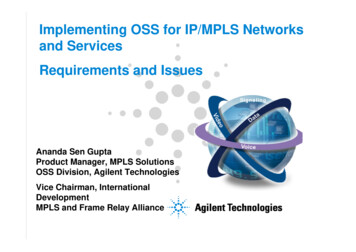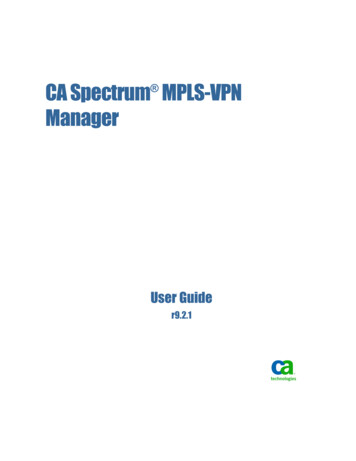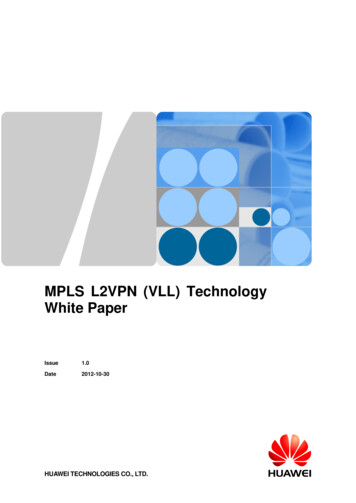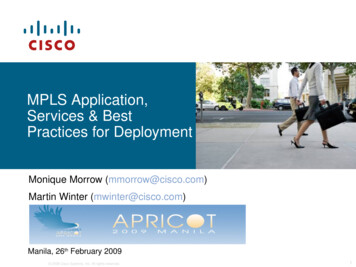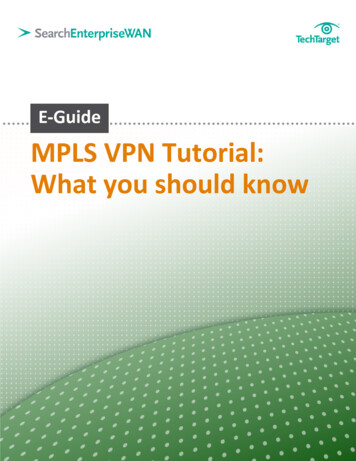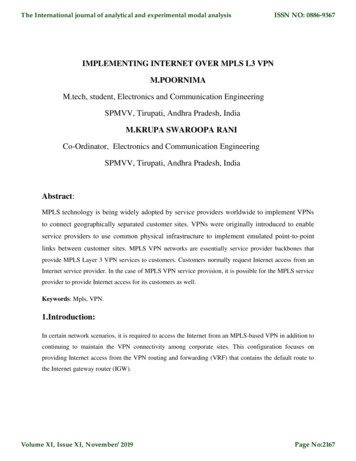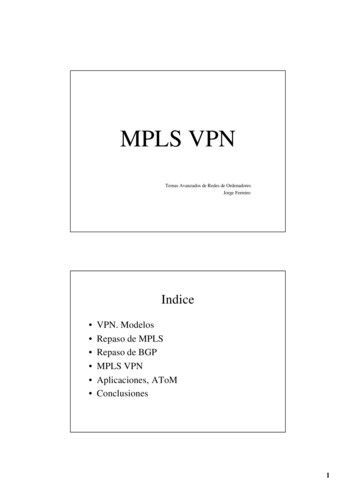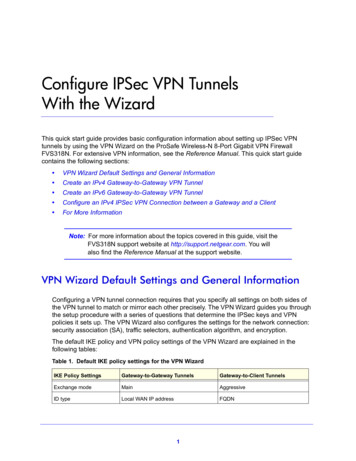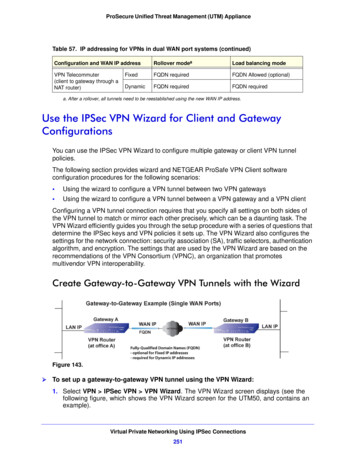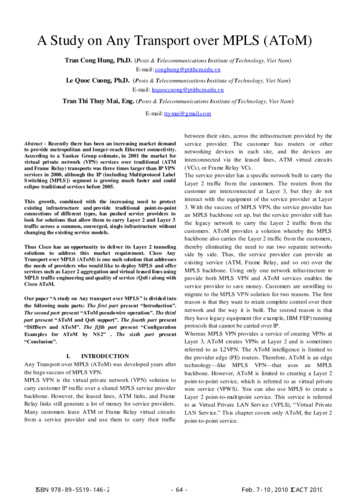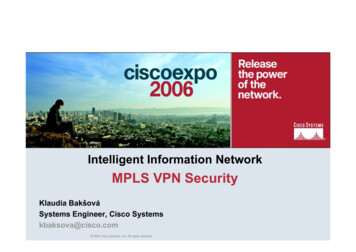
Transcription
Intelligent Information NetworkMPLS VPN SecurityKlaudia BakšováSystems Engineer, Cisco Systemskbaksova@cisco.com 2003 Cisco Systems, Inc. All rights reserved.
Agenda Analysis of MPLS/VPN SecurityInter-AS VPNsProvider Edge DoS possibility Secure MPLS VPN DesignInternet Access Security Recommendations Summary 2003 Cisco Systems, Inc. All rights reserved.2
The Principle: A “Virtual Router”Virtual Routing andForwarding Instance!ip vrf Customer Ard 100:110route-target export 100:1000route-target import 100:1000!interface Serial0/1ip vrf forwarding Customer A!Assign Interface to“Virtual Router” 2003 Cisco Systems, Inc. All rights reserved.Route Distinguisher:Makes VPN routes uniqueExport this VRF withcommunity 100:1000Import routes fromother VRFs withcommunity 100:10003
General VPN Security Requirements Address Space and Routing Separation Hiding of the MPLS Core Structure Resistance to Attacks Impossibility of VPN SpoofingWorking assumption: The core (PE P) is secure 2003 Cisco Systems, Inc. All rights reserved.4
Address Planes: True Separation!VPN1 Address SpaceCECESeveral DataPlanes:VPNv4 Addr.0.0.0.0—255.255.255.255?VPN2 Address Space0.0.0.0—255.255.255.255?PEControl Plane:IPv4 Addr.CEPCore Address SpacePECEmbehringPE-CEInterfacesBelong to VPN;Only AttackPoint!!0.0.0.0—255.255.255.255 2003 Cisco Systems, Inc. All rights reserved.5
Hiding of the MPLS Core StructureMPLS coreVisible Address Space of VPN1PEIP(PE; l0)CE1PIP(CE1)IP(PE; fa0)VRF CE1PCE2IP(CE2)IP(PE; fa1)PPVRF CE2 PE interface to CE – the only point where a VPN can ‘see’ the core and send packetsto the core device; seen and accessible from VPN1 space only, VPN1 cannot seeany other interface on the PE Only PE peer addresses of VPN1 exposed (- CE)!- ACL for PE interfaces – for ‘receive traffic’ IP unnumbered for PE interfaces – complete hiding of the core from that VPN! P routers – not reachable from VPN 2003 Cisco Systems, Inc. All rights reserved.6
Protection Against SpoofingTransit ACL* Exceptions: Inter-AS, CsCInternet ServiceProviderInternet CEInternet ustomerInternetCustomerLSP Label Spoofing - Interface between PE and CE – pure IP without labels labeled packet received from CE, PE automatically drops it Cannot spoof labels from outside! IP spoofing – possible, remains within the originating VPN – RFC2827 2003 Cisco Systems, Inc. All rights reserved.7
Inter-AS: What are we trying to achieve? An SP should have:100% (full) reachability to all Inter-AS VPNsshared between them (control plane and data plane)0% (no) reachability to VPNs that are not shared(control plane and data plane) SP networks should be independent:Must be secured against each otherNot attackable from outside (other SP, customer, Internet) 2003 Cisco Systems, Inc. All rights reserved.8
Inter-AS:What Are We NOT Trying to Achieve?Any Form of Separation Between Inter-AS VPNs (Control orData Plane) - Interconnection of VPNs is 100% No firewalling, no limitations, no sanity checkswithin an Inter-AS VPNIf an SP Holds VPN Sites in anInter-AS Set-Up, He Has Full Accessto All VPN Sites, Also on Other ASes 2003 Cisco Systems, Inc. All rights reserved.9
Inter-AS: Case AVRF-VRF Back-to-BackCust.CEAS 1Cust.AS 2CEPEASBRPEASBRmbehringLSPIP DataLSP Control plane: No signalling, no labels – interfaces external to AS are pureIP, each ASBR holds its own VRF for the shared VPNASBR - as if a single PE router connecting a CE router(the other ASBR) Data plane: IPv4 only, no labels accepted Not very scalable 2003 Cisco Systems, Inc. All rights reserved.10
Inter-AS: Case APotential Security Issues Accidental misconnection at the ASBR – SPs have to make sure theyare clear about which interface/subinterface connects which VPN Routing issues –VRFs on both ASBRs will exchange routing for a givenInter-AS VPN¾Routing security¾Prefix number limited to avoid memory overflow Security: as in RFC2547; most secure interconnection model – no labelsaccepted due to ‘PE-CE’ analogy, neighbouring AS cannot see the AS core SPs are completely separated, VRF-to-VRF connection, no global routingtable connection Neighboring ASBR - just an IP interface to MPLS core – no label spoofing 2003 Cisco Systems, Inc. All rights reserved.11
Inter-AS: Case BASBR exchange labelled VPNv4 routesCust.CEAS 1Cust.AS 2CEPEPEASBR MP-eBGP Labels ASBRmbehringLSPVPN label IP DataLSP Control plane: MP-eBGP between ASBRs, no IGP or TDP/LDP Inter-AS VPNv4 routes held in BGP table, not in VRFs Data plane: one connection between ASBRs – data plane traffic fordifferent VPNs must be kept separate – labelling packets before sendingthem to the other ASBR (label stack swapped for ASBR VPN label)¾ inherent behaviour to MP-eBGP¾ Better scalability, BGP table size might be an issue 2003 Cisco Systems, Inc. All rights reserved.12
Inter-AS: Case BPotential Security Issues No AS VPN label is checked on ASBRs when forwarding, possiblelabel spoofing data plane not possible to secure completely¾ External interfaces accept labelled packets instead of just IPpackets¾ No way for ASBR to check on the VPN membership of the packet,as there is no VRF on ASBR Control plane: ingress ASBR interfaces – ACL to filter any IP acceptBGP SPs are completely separate Visibility – only the neighbouring ASBR, via eBGP 2003 Cisco Systems, Inc. All rights reserved.13
Inter-AS Case C:ASBRs Exchange PE loopbacksCust.CEAS 1Cust.AS 2CEVPNv4 Routes LabelsPEASBR PE Loopb Labels ASBRPEmbehringPE label VPN IPDataLSP Control plane: PE visibility of both SPs – through Multihop MP-BGP ASBR exchange just PE loopback vie eBPG labels; PEs exchange VPNv4routes labels end to end without involving ASBRs no need to hold VPNspecific information, only PE loopbacks and their labels very scalable Data plane: PE label VPN label, ASBRs only as P routers, LSP built from PEin AS1 to PE in AS2 2003 Cisco Systems, Inc. All rights reserved.14
Inter-AS: Case CPotential Security Issues Security: SP must be able to reach all PEs of neighbouring AS which holdconnections of shared VPNs, issue: ASBR cannot check VPN label, seesonly egress PE label, possible VPN label spoofing probability of misinsertionControl plane: ingress ASBR interfaces – ACL to filter any IP accept BGPASBR – no VRF, no VPN routing information VPN label below egressPE label cannot be checked (e.g. intrusion – no VPN label appended, PHPpops egress PE label at P router, PE receives a pure IP packet – getsrouted into SP core)All these label spoofing attacks carried out by SP, not by customerVPN, as data can be injected at ASBR only! 2003 Cisco Systems, Inc. All rights reserved.15
The Key Issue: Designing a DoS ResistantProvider EdgeMPLS coreCustomer VPNPEPVPN CustomerVRFCE1Internet CustomerDoS AttackPInternetVRFPPP Primary prerequisite – IP address visibility PE has shared CPU / memory / bandwidth resources for different VRFs: Traffic can affect VPN customer(s) via performance degradation up to completeloss of connectivity DoS attacks usually perceived as coming from Internet, however also coming fromcustomer VPNs A way to compromise MPLS core – thorough security of PEs crucial to avoid thethreat 2003 Cisco Systems, Inc. All rights reserved.16
Today’s Best Practice: DoS Through a SharedPE Solved by Using a different designTo InternetPE1customernetworkCE1 Separate VPN and Internet trafficon physically different PE routersVRF InternetPE2CE2VRF VPN PE routers should contain onlyVRFs of the same security level.Example:Level 0: InternetLevel 1: VPN customersTo VPN Internet VPN subject to DoS attack in no different way than other networktechnologies, i.e. this is not an MPLS-specific issue DO NOT expose PE addresses to Internet at all, or with dynamic routinguse limit to routing reachability only – Infrastructure ACL! 2003 Cisco Systems, Inc. All rights reserved.17
Separate VPN and Internet AccessMPLS coreCustomer LANPTo InternetFirewall / NATCE1PE1VRF InternetIDSCE2PE2VRF VPNTo VPN Separation DoS resistance 2003 Cisco Systems, Inc. All rights reserved.18
Agenda Analysis of MPLS/VPN SecurityInter-AS VPNsProvider Edge DoS possibility Secure MPLS VPN DesignInternet Access Security Recommendations Summary 2003 Cisco Systems, Inc. All rights reserved.19
Internet Provisioning on an MPLS CoreMost common VPN user requirement – SP to provide Internet access inaddition to VPN connectivityTwo basic possibilities:1. Internet in global table, either:1a) Internet-free MPLS core (using LSPs between PEs)1b) Internet routing held by the entire MPLS core (PE and P)2. Internet in VRFInternet carried as a VPN on the core¾ Issue – how to design an MPLS core for Internet access such thatVPNs remain secure 2003 Cisco Systems, Inc. All rights reserved.20
MPLS Core Without Internet Connectivity MPLS Core – no connection to the Internet; only VPNs connect to the core, P notreachable, also PE (except in case seen below) Pure MPLS VPN service considered “most secure” – well secured againstintrusions and DoS attacks from the outside (core invisible from the outside) VPN Spoofing impossible, VPNs not reachable from the outside But what about:CE BVRF BCE AVRF AInternetServiceProviderPEPEmbehringVRF BCE BVRF ACE AmbehringInternet has become part of the VPN,above statements still hold DoS attack within such VPN – noimmense threat as access capacity of VPNA can be limited by configuration 2003 Cisco Systems, Inc. All rights reserved.21
Internet in a VRFInternet ServiceProviderInternet CEInternet ustomerInternet Routing Table(Global Routing Table)Internet in a VRFInternetCustomerVPN Routing Table (VRF) 2003 Cisco Systems, Inc. All rights reserved.22
Internet in a VRF – Security Features Internet is handled just the same as a VPN, Customer VPNs notreachable from Internet VPN The core is secure against attacks from the outside as the Internet hasno access to the core – P not reachable Spoofing is impossible between VPNs and Internet in a VPN Internet VPN – possibility of DoS of higher magnitude – PE can bereachable from Internet if not secured properly¾ Customer VPNs must not be affected - provide sufficient capacity in thecore OR use QoS to prioritize VPN traffic over Internet traffic¾ Scalability Issue – a prefix held in a VRF requires about three times asmuch memory as a prefix held in the global table additional memoryrequired 2003 Cisco Systems, Inc. All rights reserved.23
Internet in the Global Routing TableUsing LSPs Between PEsInternet Routing Table(Global Routing Table)Internet ServiceProviderVPN Routing Table (VRF)Internet CEInternet rnetCustomerVPNCustomerLSP Ingress PE - iBGP next hop - Egress PE loopbackNext hop to egress usually has label, LSP is used to reach egress PEP routers do not need to know Internet routes (nor run BGP, only IGP and LDP) 2003 Cisco Systems, Inc. All rights reserved.24
Internet in the Global Routing TableUsing LSPs Between PEs - Recommendations In this model PE routers have to carry routes for P routers in their IGP Traffic coming from the outside into a PE router's global routing table willhave normally a route to the P routers (P reachable unidirectionally) LDP and iBGP threatened via attacks against TCP – usage of MD5authentication as a solution¾ use Infrastructure ACLs to prevent packets from outside reach theinside of the core¾ use Receive ACLs and Control Plane Policing to protect the controlplane of a single platform¾ Consider using NSAP addresses in core – IS-IS 2003 Cisco Systems, Inc. All rights reserved.25
Agenda Analysis of MPLS/VPN SecurityInter-AS VPNsProvider Edge DoS possibility Secure MPLS VPN DesignInternet Access Security Recommendations Summary 2003 Cisco Systems, Inc. All rights reserved.26
Securing the Core:Infrastructure ACLsCEPEVPNIn MPLS:PE addressbelongs to VRF! Intended to filter data destined for network infrastructure equipment, i.e. whatprotocols and addresses can access critical infrastructure equipment On all reachable PE VRF interfaces:deny ip any PE – CE address space permit ip any anyexception: routing protocol from CE only and all transit traffic Idea: Protecting the Core DoS: traffic over router theoretically enables DoS, primary threat – traffic destinedfor RP iACLs also to deny source private address space, reserved addresses,SPs own address space - antispoofing 2003 Cisco Systems, Inc. All rights reserved.27
Securing the Core:Infrastructure NCE.11.1.1.8/30.2PEVPN Example:deny ip any 1.1.1.0 0.0.0.255CE.11.1.1.12/30.2This Is VPN AddressSpace, Not Core!permit ip any any Caution: This also blocks packets to the CE’s!Alternatives: List all PE i/f in ACL, or use secondaryi/f on CE 2003 Cisco Systems, Inc. All rights reserved.28
Securing the Core:PE-CE routing protocol securityIn order of security preference:1.Static: If no dynamic routing required(no security implications – no fabricated routing updates, less CPUimpact, possible sniffing not revealing routes due to no updates)2.BGP: For redundancy and dynamic updates(many security features – prefix filtering, route dampening, one BGPprocess, multiple address-families (per customer/VRF), redistribution atPE not necessary into iBGP)3.IGPs: If BGP not supported(limited security features – PE peering address known, no ‘neighbor’definition, use iACLs) 2003 Cisco Systems, Inc. All rights reserved.29
Routing Security:Neighbor Authentication and BGP TTL Use static routing between CE and PE where possibleno errant routes announced, no routing data crossing the ‘wire’, noCPU impact Routers authenticate each time a routing update is exchange betweenthem – reliable information received from a trusted sourceVerification through MD5 hash Supported: BGP, ISIS, OSPF, EIGRP, RIPv2, LDP MD5 for LDP – label spoofing protection, enable also on MP-iBGP 2003 Cisco Systems, Inc. All rights reserved.30
Control of Routes from a BGP Peer Injection of too many routes – possible attack at routing tablestability, CPU and memory:Potential DoS attack, leading e.g. to CEF disabling or reload Control with “maximum prefix” commandAfter exceeding the number – BGP peering disabled, neighbor downFrom ThisNeighbor Accept Max 45 Prefixes,Then Reset Session router bgp 13neighbor 140.0.250.2 maximum-prefix 45 80 restart 2 Log a Warningat 80% (of 45), 2003 Cisco Systems, Inc. All rights reserved. and Restart the BGPSession After Two Min.31
Control of Routes from a BGP Peer:Logging6d22h: %BGP-4-MAXPFX: No. of prefix received from 140.0.250.2 (afi 2)reaches 37, max 456d22h: %BGP-3-MAXPFXEXCEED: No. of prefix received from140.0.250.2 (afi 2): 46 exceed limit 456d22h: %BGP-5-ADJCHANGE: neighbor 140.0.250.2 vpn vrfVPN 20499 Down BGP Notification sent6d22h: %BGP-3-NOTIFICATION: sent to neighbor 140.0.250.2 3/1(update malformed) 0 bytes FFFF FFFF FF 2003 Cisco Systems, Inc. All rights reserved.32
VRF Maximum Prefix Number Injection of too many routes:Potential memory overflowPotential DoS attack For a VRF: Specify the maximum number ofroutes allowedIn This VRF Accept Max 45 Prefixes, ip vrf redmaximum routes 45 80 and Log a Warning at80% (of 45), 2003 Cisco Systems, Inc. All rights reserved.33
PE-Specific Router Security PE Control Plane hardening – Receive traffic¾ L3 routing environment (authentication, max number ofprefixes )¾ Infrastructure ACLs¾ Protection ACLs (anti-spoofing, etc.) PE Data Plane Hardening¾ Use uRPF Strict mode on each interface of the PE routers’ CEfacing interfaces and on the CE routers’ PE-facing interfaces 2003 Cisco Systems, Inc. All rights reserved.34
Attacking a CE from MPLS (other VPN) Is the CE reachable from the MPLS side?- only if this is an Internet CE, otherwise not!(CE-PE addressing is part of VPN!) For Internet CEs:Same security rules apply as for any other access router.MPLS hides VPN-CEs: Secure!Internet CEs: Same as in other networks 2003 Cisco Systems, Inc. All rights reserved.35
Agenda Analysis of MPLS/VPN SecurityInter-AS VPNsProvider Edge DoS possibility Secure MPLS VPN DesignInternet Access Security Recommendations Summary 2003 Cisco Systems, Inc. All rights reserved.36
Securing the MPLS Core: Wrap-UpMPLS coreBGP Route EBGP peering withMD5 authentic.LDP with MD5CE 2003 Cisco Systems, Inc. All rights reserved.CECEACL andsecure routing37
MPLS Security Overview1. Don’t let packets into (!) the coreÆ No way to attack core, exceptthrough routing, thus:2. Secure the routing protocolNeighbor authentication, maximumroutes, dampening, 3. Design for transit trafficQoS to give VPN priority over InternetChoose correct router for bandwidthStill “open”:routingprotocolOnly attackvector: TransittrafficNow onlyinsider attackspossibleSeparate PEs where necessary4. Operate Securely 2003 Cisco Systems, Inc. All rights reserved.Avoid insiderattacks38
Internet Provisioning on an MPLS Core Most common VPN user requirement - SP to provide Internet access in addition to VPN connectivity Two basic possibilities: 1. Internet in global table, either: 1a) Internet-free MPLS core (using LSPs between PEs) 1b) Internet routing held by the entire MPLS core (PE and P) 2. Internet in VRF
